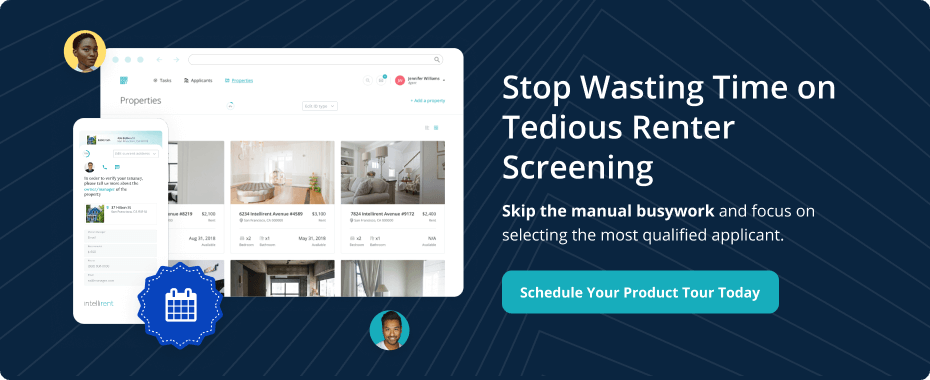March 30, 2023 • 10 min read

One bad tenant can wipe out years of profits from your rental property. Choosing the right tenant is one of your most important decisions.
A good tenant will pay on time, take care of your property, and leave the home better than they found it. In contrast, a bad tenant can cost you thousands of dollars in property damage and missed rent.
So how do you ensure you get more of the good ones and fewer of the bad ones? Follow a solid tenant screening process.
In this article, we'll lay out the ideal step-by-step process for how to screen tenants for your rental property. We'll cover the most critical steps to take to make an informed decision when choosing a renter. We will also look at some common mistakes landlords and agents make during the screening process and how to avoid them.
By the end of this guide, you'll have a solid understanding of how to screen tenants effectively and confidently so that you can make the right decision for your rental property. You’ll know what green flags to look for, what red flags to watch out for, and how to determine which applicant will be the best fit for your property.
How to Screen Tenants Effectively
Conducting comprehensive tenant screening requires a robust screening process and tools to support it. Start with a robust online application that collects the exact information that you need. Be sure that all required documentation is collected and verified. Finally, compare all applicants against your ideal renter criteria to select the most qualified applicant.
Sounds simple enough, right?
However, skipping steps or skipping screening entirely can lead to detrimental downstream effects.
That’s why we created this guide: to lay out the ideal steps to thoroughly screen tenants and approve only qualified applicants.
Intellirent has screened over half a million tenants. Through extensive trial and testing, we’ve developed the ideal tenant screening service. This article will give you everything you need to screen tenants at the highest possible level, without wasting days doing paperwork.
Why is Screening Tenants Important?
Effective tenant screening protects your client’s property and your reputation. Sending all applicants through a robust screening process helps you make informed decisions about who to rent to.
Proper tenant screening can help minimize the risks of renting to bad tenants, such as unpaid rent, property damage, and high vacancy rates. Bad renters tend to create unnecessary frustration and upset the neighbors.
On the other hand, great renters will pay rent on time, stay longer, maintain the property, and allow you to grow the business when you’re not bogged down with problems.
By conducting a thorough screening process, landlords and property managers can increase their chances of finding a reliable and responsible tenant, leading to a positive rental experience for everyone.
What to Look for in Rental Tenants?
When screening tenants and reviewing applications, it’s important to know what to look for. Effective screening isn’t as simple as looking at the credit score and reported income. There are a lot of important nuances to consider.
Tenant Green Flags
- Income that’s 2.5-3x rent, depending on location
- A stable, reliable job with consistent income
- Good credit score and report indicating consistent payment history
- Excellent rental history, verified by past landlords
- Responsive and transparent during the screening process
Tenant Red Flags
- History of evictions or refusing to provide rental history. Residents that have to be evicted tend to have nearly 3x as many prior rental-related collection records as non-evicted residents.
- Lots of job-hopping and income that varies dramatically from month to month
- The credit report shows a history of missing payments
- Complaining, failing to follow instructions, or withholding information
- Reported data and verified data don't line up
How to Screen Tenants in 10 Steps
- Research Your Rental Landscape
- Determine Your Ideal Renter Criteria
- Get to Know Each Potential Renter
- Ask Prospective Tenant to Complete the Rental Application
- Validate Documentation
- Obtain Credit Reports
- Verify Employment & Income
- Verify Rental History
- Review the Complete Application
- Communicate Acceptance and Get the Lease Signed
Step 1: Research Your Rental Landscape
Before you start screening tenants, it’s important to understand the rental landscape you are operating within. Be sure you’ve considered the following:
- What federal laws affect your tenant screening process? For example, the Fair Housing Act, Equal Credit Opportunity Act, and the Fair Credit Reporting Act.
- What are the local laws and regulations that affect rental properties? For example, are there laws that restrict the use of criminal background information in tenant screening?
- What requirements do you have for tenants?
- What will you set the rent at for the unit?
Step 2. Determine Your Ideal Renter Criteria
Ideal renter criteria refer to the standards and qualifications that leasing professionals use to determine the most suitable renters for their properties.
These criteria can include factors like:
- Minimum income
- Minimum credit score
- Criminal background (if applicable in your location)
- Acceptable documents for the source of income and employment history
- Rental history
- Pets or types of pets
Step 3. Get to Know Each Potential Renter
Before potential tenants apply, getting to know them a little is important. When meeting to show the rental in person, talking through your criteria and asking questions helps you determine whether the applicant is likely to qualify and if they’d be a good fit for the property.
Be sure to communicate your ideal criteria to potential renters. This transparency will help them decide if they should apply. Some questions to consider asking include:
- Will you tell me a little about yourself?
- Who will be living in the property?
- Why are you looking for a new home?
- What is your current employment status and income?
- How long have you been employed at your current job?
- Have you ever been evicted?
- What is your current credit score?
- Do you have any pets?
Step 4. Ask Prospective Tenant to Complete the Rental Application
Online rental applications are more secure and reliable than paper applications.
By using a robust screening service like Intellirent, you can customize your application to ensure that you collect all necessary information and documentation. This prevents unnecessary back and forth with applicants and streamlines the application process.
Step 5: Validate Documentation
Unfortunately, some applicants will try to photoshop or alter documentation to make their application seem better. Review all submitted documentation for signs of tampering to prevent yourself from being deceived.
Tools like Intellirent can detect document falsification and notify you.
Step 6: Obtain a Credit Check
Use an online service to run a credit and background check. Don't accept a report directly from the applicant, as it may be altered. Instead, go directly to one of the bureaus to request a complete credit report.
Make sure that the service you choose provides the actual credit score in addition to the payment history report, as it provides a summary of all the data.
Often the details in the report can give you valuable context on how reliable the applicant is when it comes to making consistent payments.
Step 7: Verify Employment & Income
An employment verification will help to confirm the applicant is in good standing with their employer, while income verification ensures that the reported income is both accurate and meets your affordability criteria.
Verifying employment involves first collecting a signed authorization to release form from the applicant. Then, contacting their employer, by either phone or email, to request information about the applicant.
Collect and review proof of income documentation, such as pay stubs, to verify income. Aligning the stated applicant information with verified data is important in catching red flags.
Step 8: Verify Rental History
Rental history verification is the process of checking a prospective renter's previous rental experience. This information is obtained by contacting a prospect’s previous landlords or property managers and asking questions about their payment history, compliance with lease agreements, and any past evictions.
While most evictions will show up in a background check, a rental history verification is important because a growing number of local regulations have prevented certain cases and details from being released. You’ll have the direct opportunity to learn about how consistent the applicant is with paying rent on time and whether there were any problems with them breaking lease agreements.
Similar to employment verification, the applicant’s signed authorization to release form will have to be collected. Intellirent provides free employment and rental history verification as part of our tenant screening service.
Step 9: Review the Complete Application
Now it’s time to review the comprehensive application. Carefully read through the provided information, documentation, and verification data. Check the credit history, read through the answers to application questions, and review the information provided by verifications.
Try to “connect the dots”: everything should align to tell the renter’s story.
Be on the lookout for any red flags or potential problems. Now is the time to be thorough and take your time to make sure you don’t miss anything.
Compare the application against your ideal renter criteria. Consider which factors are the most important considerations for this particular property, and don’t forget about the move-in date. When your vacancy is ready for move-in now, a renter looking to move-in in a month or more may not be the best fit.
Determine which application is the closest match to your ideal criteria. Be sure to keep track of when each application is received and accept the first qualified applicant.
Step 10: Communicate Acceptance and Get the Lease Signed
Once you’ve made a decision, contact the most qualified applicant to let them know they are approved. Don’t delay making this phone call! Highly-qualified applicants are in demand, be sure to reach out as soon as possible to ensure they don’t accept an offer elsewhere.
After you’ve confirmed the acceptance, have simple and clearly defined next steps for the renter to quickly get the lease signed and collect the move-in funds. Using a digital lease tool makes it easy to create, send, and get the lease signed in minutes. Don’t leave anything in limbo. Have a plan of action to notify any applicants that did not qualify.
Tenant Screening Tips & Best Practices
Tenant screening might seem like a fairly straightforward process. However, there are many ways to get it wrong and tremendous risks if you do. Here are some helpful tenant screening tips discovered through many conversations with leasing professionals.
- Consistently follow a uniform screening process for all. Never skip screening or bend your rules for anyone, even someone you know personally.
- Don’t skip verifying employment and rental history; you can learn a lot from these verifications that would otherwise be missed. The questions you ask should be based on data, not just opinion.
- Follow all fair housing laws and be fair and impartial when evaluating prospective tenants. Do not make decisions based on protected classes, such as race, religion, or national origin.
- Keep detailed records of all information obtained and all decisions made. This helps to ensure accountability and can protect against legal challenges in the future.
- Stay up-to-date on all legal requirements regarding screening for residential rental properties.
- Join your local apartment or rental housing association for resources, educational materials, and updates on changes in local regulations.
- Use tenant screening software like Intellirent to remove friction from your screening process. Intellirent helps you save time in rental advertising, screening, verification, and document management.
How to Screen Tenants in Under 24 Hours
Screening is an essential part of the rental process. A poor process can lead to significant risks and consequences, including financial losses, property damage, and reputational damage.
That's why it's critical to follow a robust tenant screening process that’s thorough, reliable, and compliant.
And while it’s technically possible to screen prospective renters by manually entering data, making verification calls yourself, and communicating back and forth with applicants to get proper documentation, the process is much smoother and faster with tenant screening software like Intellirent.
Intellirent accelerates the screening process by eliminating friction and manual busywork. We empower you to attract and screen renters by collecting and validating documents and verifying income, employment, and rental history, all without lifting a finger.
Intellirent’s Leasing Tools streamline your screening process. You’ll receive credit, background, and application information instantly and complete verifications within 24 hours.
With Intellirent, you can make informed, confident decisions about who you rent to, helping to protect your rental business.
Don’t waste another minute on ineffective, inefficient screening processes. Schedule a product tour today to experience the peace of mind that comes with a comprehensive and automated tenant screening process.
Published by Cassandra Joachim
March 30, 2023
Related Articles
May 09, 2023 • 7 min read
April 25, 2023 • 25 min read
Subscribe For Insights
Get actionable leasing tips, tools, and best practices directly to your inbox. Don't miss out on the insights that'll help your team confidently find, screen, and approve the most qualified renters.


.jpg)